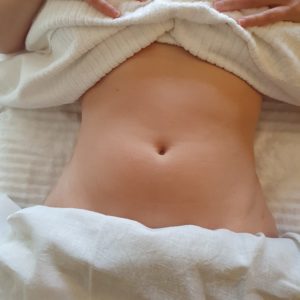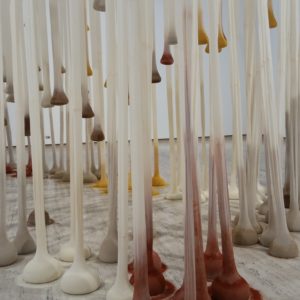What is Lymphatic Drainage Massage?
- Lymphatic drainage therapy stimulates your immune and circulatory systems, giving you an overall immunity boost and prevent inflammation and swelling.
- It is a gentle form of massage used to relieve painful swelling in your arms and legs caused by lymphoedema. Lymphoedema often affects people recovering from breast cancer surgery where nodes and breast tissue have been surgically damaged and / or removed.
- Manual lymphatic drainage is a gentle massage to encourage the natural drainage of the lymph from the body tissue. (Lymph is the fluid that circulates in the tissue space/interstitial throughout the lymphatic system.)
- The technique is light with gentle pressure mobilising fluid toward the lymphatic sites, with varying degrees of pressure in the actual sites (chest, neck, pelvis, axilla (armpit), inguinal (groin) region) and in association with the blood vessels of the intestines.
-
Lymphatic drainage massage or therapy also known as manual lymphatic drainage (MLD)
 Benefits of Lymphatic Drainage:
Benefits of Lymphatic Drainage:
Lymphatic drainage is beneficial for most people, with a lymph condition or not, as it helps to stimulate your immune system and circulatory system, giving you an overall immunity boost.
- Reduce inflammation and swelling
- Aid recovery (health condition, post-surgery, slow recovery, etc.)
- Move and drain congestion
- Stimulates circulation
- Relaxes your nervous system
- Aids your immune system (particularly beneficial for those recovering from respiratory infections, chronic fatigue, and for the physically inactive; or recuperation from long illness or surgery; and ongoing rehabilitation such as cancer treatment plans)
- Aids detoxification
- Supports stop smoking/alcohol treatment
- Post-surgery for knee and hip replacements
- Post-menopausal symptoms
The Healing Practice has 5 “Add On ‘ treatments to complement Lymphatic Drainage Therapy!
The Full Body ‘Circulate Compression System’
(Compression Circulate System with garment ‘sleeves’ to target specific ‘problem’ areas on a clients body)
Facial Sculpting & Buccal Massage Trio Deluxe
The Celluma Pro LED Light Therapy Add On
The Gua Sha Facial & Foot Reflexology Add On
The Back Scrub and Foot Reflexology Add On
 More About Conditions that Require Lymphatic Drainage
More About Conditions that Require Lymphatic Drainage
Lymphoedema – also know as lymphatic obstruction, is a condition of localised fluid retention and tissue swelling caused by a compromised lymphatic system. There is both primary (which may be inherited) and secondary lymphoedema, (which occurs due to injury to the lymphatic vessels and nodes). Such as cancer patients that in the course of their treatment from surgery, where lymph nodes have been removed or destroyed from radiation therapy, are most at risk in developing lymphoedema.
Treatment for lymphoedema – may vary according to the severity of the oedema and associated symptoms. Most people with lymphoedema manage their condition themselves, with a regime of self-care interspersed with other treatment and medical advice when appropriate. The most common treatments are a combination of manual lymphatic drainage, compression garments and bandaging. Although more ideal together, any of the treatments can be done individually.
Oedema – is a build up of fluid when the lymphatic system struggles (but is not damaged) to remove the excess fluid. Causes include the body’s reaction to hot weather, a high salt intake, stress and the hormones associated with the menstrual cycle, pregnancy or menopause. Symptoms include swelling of body parts such as feet, hands and ankles, a feeling of stiffness or aching and weight fluctuations.
Treatment for oedema – though much less serious and mostly a short-term condition, it is generally treated in the same way as lymphoedema. Pregnancy oedema is often relieved by elevation of the feet and rest. Wheras severe oedema accompanied by other symptoms; such as protein in the urine, sudden onset of headaches, blurred vision, epigastric pain, can be symptomatic of pre-eclampsia (a type of pregnancy induced hypertension).
Post-menopausal oedema may be exacerbated by a less active lifestyle, more sedentary work and family needs overwhelming a woman’s coping abilities. This gap between meeting her needs and that of others can unhappily tip a woman towards weight gain and a dysregulation in some of her body systems.
Is Lymphatic Drainage Helpful After a Hip or a Knee Replacement?
Yes, lymphatic drainage massage can be very helpful after a hip replacement surgery, as it can significantly reduce swelling, pain, and discomfort around the affected area by promoting proper lymph fluid flow, thereby aiding in the healing process and improving recovery time; most experts recommend consulting with a qualified therapist to discuss the appropriate timing and techniques for post-surgical lymphatic drainage.
Key points about lymphatic drainage after hip replacement:
Why is there swelling /inflammation around the surgical site of your knee or hip?
It is important to know that the swelling (inflammation) is a normal by-product of the surgery. The swelling is a natural response to the surgery as a protective mechanism around the trauma site. However, this swelling can also reduce your recovery to some extent which is why lymphatic drainage can assist with your recovery.
Reduces swelling:
- The primary benefit is the reduction of post-surgical swelling due to the improved drainage of excess fluid from the area.
Pain relief:
- By decreasing fluid buildup, lymphatic drainage can also help alleviate pain and discomfort around the hip joint.
Improved circulation:
- The gentle massage techniques stimulate blood flow, which can further promote healing.
Scar tissue management:
- Lymphatic drainage can help to minimize the formation of excessive scar tissue around the incision site.
Important considerations:
- Consult your doctor:
- Always discuss with your surgeon or physical therapist before starting lymphatic drainage massage post-surgery to ensure it is appropriate for your specific situation.
Timing is crucial:
- Typically, lymphatic drainage massage is recommended to begin a few days after surgery, once the initial healing phase has started.
Qualified therapist:
It’s essential to seek a certified lymphatic drainage therapist who is experienced in post-surgical care.
The Healing Practice
7 Albert Street,
Forest Lodge (Glebe) NSW 2037
By Appointment Only
Call Claire on 0438 216 351
Or Contact Us
Lymphatic Drainage Assists with: 
- Lymphoedema
- Cellulite treatment
- Children with respiratory conditions
- Pregnant or Postnatal women with oedema (fluid retention)
- Postnatal recovery
- After a miscarriage
- Menopause or hormonal alterations and disturbances
- Post-surgical operations
- Knee and hip reconstruction surgeries
- Cancer Treatment (such as breast cancer)
- Elderly people suffering with oedema
- Chronic fatigue syndrome
- As part of a ‘Detox’ health plan (such as dietary or ‘stop smoking’)
- Immune system deficiency
See our new ‘Add On’ treatments to improve your Lymphatic Drainage Treatment
Schedule Your ‘Facial Sculpting & Buccal Massage Trio’ Deluxe Treatment Now!
Schedule your ‘Lymphatic Circulate Compression & Breathwork Duo Treatment’ today!
Function of the Lymphatic System:
- Addresses biological infections (bad icky things!), as well as biological breakdowns or errors within the body, as in the response to cancer
- Responsible for the removal of interstitial fluid from tissues in the body
- Absorbs and transports fatty acids and fats as chyle from the digestive system
- Transports white blood cells to and from the lymph nodes into the bones
- Transports antigen-presenting cells (APCs), such as dendritic cells, to the lymph nodes where an immune response is stimulated
What to Expect:
A history is taken at the beginning of each appointment so the treatment can be correctly tailored to your particular needs. Most of the major lymphatic sites are gently worked upon, although this will depend on your symptoms and requirements. Lymphatic massage is light and gentle, and you can expect to feel comfortable and relaxed. As toxins are aided to leave the body, increased urination after a treatment is a healthy by-product. You will feel ‘lighter’ in body with an increase in energy. If you are detoxing, there may be a temporary increase in skin outbreaks or nausea, as the stimulated liver flushes out extra toxins. Drinking more water aids this natural process.
Tips to Help You Stay on Your Treatment Plan:
- Drink more water
- Eat more green, leafy vegetables and protein
- Eat good food and get rid of the junky stuff especially sugar as the excess converts to fat stores!
- Reward yourself with healthy treats so your mind and body can appreciate the difference
- Exercise in whatever way works for you, starting small and enjoying your exercise
- Burn fat with weight training
- Improve your ‘sleep hygiene’ (what’s that? at least 7-8 hours every night)
- Reward yourself with ‘rest hygiene’ (what’s that? nurturing activities that are restful and restorative)
Cancer and Massage
Often people worry that massage is contraindicated for various cancers and is likely to increase the cancer. This is not the case. Research shows that cancer develops and spreads because of changes to a cell’s DNA (genetic mutations) and other processes in the body.
There are many reasons to have massage during all stages of cancer. Direct massage should be generally avoided on tumours or treatment sites, primarily to avoid discomfort to the person or put pressure on the affected area and underlying organs. However, certain cancers such as Hodgkins Lymphoma, which is a cancer of the lymphatic system may require a different approach.
Read more at http://www.cancercouncil.com.au/17958/b1000/massage-and-cancer-42/massage-and-cancer-benefits-of-touch/#7WdH1tIHXqSddCxO.99
What is the Lymphatic System?
The lymphatic system is part of the circulatory system and immune system, comprising a network of lymphatic vessels that transport a clear fluid called lymph, directionally toward the heart. These vessels carry lymph to the various lymph nodes for ‘processing’. Lymph nodes are major sites of immunity cells, such as B, T, and others. Lymph nodes act as filters or traps for foreign particles, and are important in the proper functioning of the immune system. They are packed tightly with the white blood cells called lymphocytes and macrophages which process pathogens.
The lymphatic system depends on peristalsis (propulsion of the lymph due to alternate contraction and relaxation of smooth muscle), and the movement of skeletal muscles to propel lymph back to the cardiovascular system. This means, healthy digestion, regular elimination, and physical movement are important to move the lymph along.
More Lymphatic Information:
- The circulatory system processes an average of 20 litres of blood per day through capillary filtration which removes plasma while leaving the blood cells. Roughly 17 litres of the filtered plasma actually get reabsorbed directly into the blood vessels, while the remaining 3 litres are left behind in the interstitial fluid.
- The thymus gland and spleen are important in the function of the lymphatics. The thymus gland is a lymphatic system organ and makes T-cells; which locate and destroy invading pathogens in the blood stream and lymphatic system. The Spleen organ plays multiple supporting roles in the body. It acts as a filter for blood as part of the immune system. Old red blood cells are recycled in the spleen, and platelets and white blood cells are stored there. The spleen also helps fight certain kinds of bacteria that cause pneumonia and meningitis.
What Products Do I Use?
I use light, absorbable and nutritious oils with additives of essential oils and therapeutic herbs. My use of essential oils is mindful of individual need and preferences, such as allergies, pregnancy and proper dosage.
Who cannot be treated?
Contraindications for Lymphatic Drainage Massage are Oedema that is the result of kidney failure, heart failure, liver disease, local infection, blood clots and DVT (Deep vein thrombosis). Also active chemotherapy for cancer treatment is another contraindication.
What about rebates?
Health funds that cover remedial massage will also cover you for lymphatic drainage, as a treatment will generally include some light remedial at neck and shoulders and your spine. Via Hicaps, you can claim your rebate on the spot in clinic.
The Healing Practice
7 Albert Street,
Forest Lodge (Glebe) NSW 2037
By Appointment Only
Call Claire on 0438 216 351
Or Contact Us
